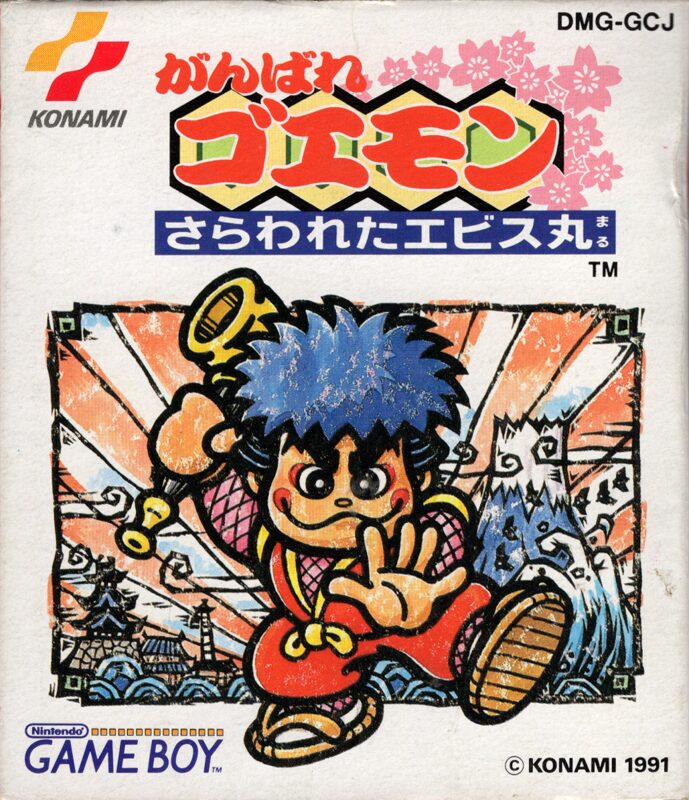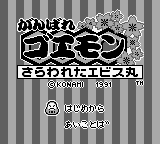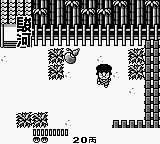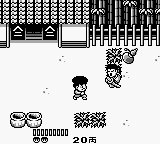Retro Replay Review
Gameplay
Ganbare Goemon: Sarawareta Ebisumaru! brings the series’ trademark blend of platforming and light RPG mechanics to the Game Boy in surprisingly robust form. From the moment you step into the first village, you’re free to explore winding streets, chat with quirky townsfolk, and accept simple fetch quests involving hidden keys, stolen loot, or misplaced items. Movement feels crisp on the D-pad, and Goemon’s basic attack—his trusty pipe—responds reliably as you clear enemies and environmental hazards.
(HEY YOU!! We hope you enjoy! We try not to run ads. So basically, this is a very expensive hobby running this site. Please consider joining us for updates, forums, and more. Network w/ us to make some cash or friends while retro gaming, and you can win some free retro games for posting. Okay, carry on 👍)
Combat encounters strike a balanced pace between reflex-driven action and strategic item use. Beyond Goemon’s pipe, you’ll discover shurikens, bombs, and other special tools that consume limited ammo but deliver satisfying payoff against tougher foes. While the action stays approachable for newcomers, carefully managing your health-restoring onigiri and ammunition for special weapons becomes essential in later stages, preventing the game from growing mundane.
RPG elements are woven in through a straightforward quest-and-reward loop. NPCs scatter clues to the next dungeon, grant side missions for extra rupees, or sell upgraded gear when you’ve met certain conditions. Experience points aren’t tracked numerically; instead, your strength increases by finding treasure chests or earning new items, keeping progression simple yet motivating. This “RPG-lite” approach ensures the pace never slows to a grind and encourages repeated visits to each locale in search of hidden secrets.
Graphics
On Game Boy hardware, Ganbare Goemon shines by making smart use of monochrome palettes and sprite layering. Goemon and Ebisumaru are drawn with exaggerated silhouettes that read clearly even on the smallest handheld screen, and enemy designs run the gamut from comical samurai foot soldiers to mischievous tanuki spirits. Background tiles are detailed just enough to evoke feudal Japanese towns, mountain passes, and castle interiors without overwhelming the eye.
Animation is surprisingly fluid for a first-generation Game Boy release. Goemon’s running, attacking, and hurt frames flow smoothly, and enemy movements feel purposeful rather than jerky. Environmental effects—like flowing water in moats or flickering torches in dungeons—are handled with simple but effective tile swaps, lending each area a distinct personality despite the system’s limitations.
Screen readability is excellent, with well-contrasted sprites against the background and intuitive on-screen icons for health and ammo. Load times are virtually nonexistent, so transitioning between towns and stages feels seamless. While you won’t see shading or color, the art direction does a lot with black-and-white pixels to ensure every building, tree, and signpost is instantly recognizable.
Story
The narrative kicks off with a classic damsel-rescue premise—Goemon’s loyal sidekick, Ebisumaru, has been kidnapped by a mysterious new villain aiming to seize control of Japan. This simple setup unfolds through short cutscenes and playful dialogue interludes, setting the tone for a rollicking adventure rather than a weighty epic. Fans of the series will appreciate recurring jokes and the banter between Goemon’s earnest heroism and Ebisumaru’s comic relief.
Dialogue is delivered in bite-sized snippets, perfectly suited to handheld play. NPCs often break the fourth wall with tongue-in-cheek commentary about Goemon’s quest or tease secret treasures that encourage exploration. Though the story rarely takes itself too seriously, it provides just enough incentive to push forward, and each new town or dungeon reveals a fresh twist on the central kidnapping mystery.
Quest design reinforces the narrative by weaving story tidbits into every mission. Recovering a stolen sword might unlock a clue about the kidnapper’s identity, while retrieving a sacred flower could gain you access to a hidden shrine. These narrative breadcrumbs maintain momentum and make the pursuit of Ebisumaru feel personal rather than perfunctory, lifting the overall charm of the adventure.
Overall Experience
Ganbare Goemon: Sarawareta Ebisumaru! succeeds as both a portable introduction to the Goemon universe and a standalone action-adventure title. Its tight controls, varied weapon roster, and balanced difficulty curve make it a joy to play in short bursts or longer sessions. The absence of deep leveling systems keeps the focus squarely on exploration and clever item use, ensuring the experience never drags.
Replay value comes from discovering optional side quests, hunting down hidden upgrades, and mastering the timing of Goemon’s special abilities. Collectibles and secret paths reward players who pay close attention to environmental hints, while the soundtrack’s catchy chiptune melodies keep you humming along even after the game cartridge is put away.
For fans of classic top-down adventure games or anyone seeking a charming, bite-sized action-RPG on the go, Ganbare Goemon: Sarawareta Ebisumaru! is an essential pick. Its blend of humor, tight design, and series-iconic flair shine through despite the Game Boy’s hardware constraints, making this title a must-have for collectors and newcomers alike.
 Retro Replay Retro Replay gaming reviews, news, emulation, geek stuff and more!
Retro Replay Retro Replay gaming reviews, news, emulation, geek stuff and more!







Reviews
There are no reviews yet.